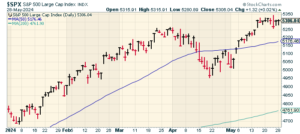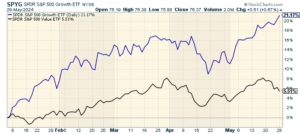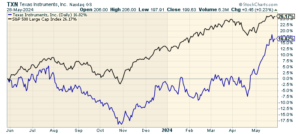CWS Market Review – May 28, 2024
(This is the free version of CWS Market Review. If you like what you see, then please sign up for the premium newsletter for $20 per month or $200 for the whole year. If you sign up today, you can see our two reports, “Your Handy Guide to Stock Orders” and “How Not to Get Screwed on Your Mortgage.”)
This week, the stock market looks to close out a strong May. This is very much welcomed after a relatively poor April. Earlier today, the Nasdaq closed above 17,000 to reach a new high. That’s a 10-fold increase in 15 years.
We have a decent earnings season to thank for May’s rebound. The overall earnings results weren’t spectacular, but they were much better than what had been expected. As always, what matters on Wall Street is how well one does compared with expectations.
Wall Street isn’t much bothered by Armageddon, as long as it’s unfolding better than their models told them it would.
Historically, the early part of summer has been a mildly positive time of year for stocks. Since 1957, the S&P 500 has gained an average of 2.28% from May 25 to July 17. That’s about one-fifth of the index’s average annual capital gain. After that, however, the market hasn’t gotten moving again until late October.
Growth Is Leading Value
I like to keep an eye on how well Growth stocks are doing versus Value stocks. This is a quick and easy way to read the mind of the market. If Wall Street starts to get nervous, then Value stocks tend to do well, but if Wall Street is feeling optimistic, then Growth stocks take charge.
Lately, I’ve been impressed by how well Growth stocks are doing. Shares of Nvidia (NVDA), the growthiest of all, got another 7.1% boost today. That’s a gain of $180 billion.
The Growth/Value tradeoff tends to be cyclical. In plain English, once Growth starts beating Value, or vice versa, you can expect that to last for several months, or even several years. When Value leads Growth, it tends to be swift and sharp; but when Growth leads, it tends to be long and steady.
Here’s the S&P 500 Value ETF (in black) and the S&P 500 Growth ETF (in blue) since the early part of this year:
Last year, Growth stocks did very well against Value stocks, except for the last part of the year when Value started to shine. Since the start of this year, Growth has gotten its groove back, especially in the last few weeks. On Tuesday, the S&P 500 Growth ETF (SPYG) outpaced the S&P 500 ETF (SPY) for the sixth day in a row.
Value stocks also tend to do well when short-term interest rates are going down. While that’s not happening at the moment, there’s a good chance rates will start to come down before the end of this year.
Are Growth stocks telling us to be optimistic? Could be. Today’s consumer confidence report was unexpectedly strong. For May, the Consumer Confidence Index rose to 102. This was the first increase in four months. The reading for April was revised higher to 97.5.
Despite today’s report, consumer confidence has generally been dour in recent months. This has perplexed some analysts because the overall economic performance hasn’t been so bad. Kyla Scanlon has dubbed this effect the “vibe-cession.”
I suspect that certain problems in the economy have an outsized impact on the public’s perception of the economy. Inflation is a good example, particularly car insurance costs.
Since December 2021, car insurance costs are up by 45.8%. Consumers are very sensitive to these costs even though car insurance makes up less than 3% of the CPI. Consumers “feel” that increase more than they do other prices. Since 2019, the price of a Big Mac has doubled.
On Thursday, the government will release its first revision to Q1 GDP. The initial report said that the economy grew in real annualized terms of 1.6% for the first quarter of this year. That’s not that great and it’s down from some strong numbers for the second half of last year. Wall Street thinks the government will revise Q1 GDP down to 1.2%.
Elliott Looks to Shake Up Texas Instruments
This morning, Elliott Investment Management sent a letter to the board of directors of Texas Instruments (TXN) recommending some major changes.
Elliott is a well-known activist hedge fund. By activist, I mean a fund that takes a large position in a stock and then advocates for some important changes in the hopes of giving the stock a boost. Oftentimes, this means paying out a dividend or boosting capital expenditures.
Activist funds are a controversial topic and I can easily see both sides of the debate. Critics say that activist funds are out to make a quick buck (or several billion bucks) and are willing to sacrifice the long-term financial stability of the company to get the share price moving.
Activist defenders claim they’re merely defending shareholders and protecting them from sclerotic management. I won’t settle the debate here, but it’s been going on since the days of Gordon Gekko in Wall Street.
Elliott now owns $2.5 billion of Texas Instruments stock. TXN used to be a very good stock until about three years ago. It’s been lagging badly since then. In 2022, TXN made $9.41 per share. This year, it’s expected to make $5.16 per share.
According to Elliott, TXN can vastly improve its free-cash flow. Elliott thinks TXN can deliver free-cash flow of $9 per share by 2026. That’s 40% above what Wall Street currently expects.
As much as the activists are criticized, I have to concede that they often make good points. From CNBC:
Elliott believes Texas Instrument’s rigid adherence to a capital expenditure plan put in place in 2022 has eviscerated shareholder returns by greatly reducing a metric by which TI has always asked to be judged – free cash flow.
Citing the reduction of free cash flow from $6.40 a share in 2022 to an expected $1.83 a share this year Elliott maintains that TI has alienated investors who might otherwise gravitate to its dominant position in serving the automotive and industrial complexes with analog chips. Its stock price, Elliott insists, has suffered as a result, trailing its peer group by substantial margins over the last two, four, six and ten year periods.
The focus of Elliott’s letter is the 2022 capital expenditure plan which called for TI to ramp its Capex spending to a high of $5 billion a year from 2023-2026 bringing that spending to as much as 23% of revenues from what had been capex spending of roughly 5% revenues over the preceding decade.
This morning, the shares opened 3.4% higher and touched a new 52-week high. If the market responds that way, it’s difficult to say that activists aren’t serving the needs of shareholders.
As far as these letters go, Elliott was much friendlier than most. Still, Elliott can easily be ignored. Even a large firm like Elliott owns a little over 1% of the outstanding shares. These activist moves always make me wonder if they truly want changes or if they are only interested in the one-day rally on the news that an activist fund is getting involved.
A similar event happened recently to one of our Buy List stocks. I’ve long been a fan of Miller Industries (MLR), and it’s done well for us this year.
In March, an activist fund that owns 3.25% of Miller sent a letter to Miller’s board recommending several changes. The firm criticized Miller’s executive pay and suggested a share buyback and a dividend hike.
Miller said that the fund’s letter was “a self-serving and short-sighted public complaint, with spurious allegations and no credible path for long-term value creation.” Still, a few days later, Miller announced a $25 million share buyback. For the most part, boards should be focused on growing the business and should be neutral on a company’s share price.
That’s all for now. I’ll have more for you in the next issue of CWS Market Review.
– Eddy
Posted by Eddy Elfenbein on May 28th, 2024 at 8:37 pm
The information in this blog post represents my own opinions and does not contain a recommendation for any particular security or investment. I or my affiliates may hold positions or other interests in securities mentioned in the Blog, please see my Disclaimer page for my full disclaimer.
-
-
Archives
- April 2025
- March 2025
- February 2025
- January 2025
- December 2024
- November 2024
- October 2024
- September 2024
- August 2024
- July 2024
- June 2024
- May 2024
- April 2024
- March 2024
- February 2024
- January 2024
- December 2023
- November 2023
- October 2023
- September 2023
- August 2023
- July 2023
- June 2023
- May 2023
- April 2023
- March 2023
- February 2023
- January 2023
- December 2022
- November 2022
- October 2022
- September 2022
- August 2022
- July 2022
- June 2022
- May 2022
- April 2022
- March 2022
- February 2022
- January 2022
- December 2021
- November 2021
- October 2021
- September 2021
- August 2021
- July 2021
- June 2021
- May 2021
- April 2021
- March 2021
- February 2021
- January 2021
- December 2020
- November 2020
- October 2020
- September 2020
- August 2020
- July 2020
- June 2020
- May 2020
- April 2020
- March 2020
- February 2020
- January 2020
- December 2019
- November 2019
- October 2019
- September 2019
- August 2019
- July 2019
- June 2019
- May 2019
- April 2019
- March 2019
- February 2019
- January 2019
- December 2018
- November 2018
- October 2018
- September 2018
- August 2018
- July 2018
- June 2018
- May 2018
- April 2018
- March 2018
- February 2018
- January 2018
- December 2017
- November 2017
- October 2017
- September 2017
- August 2017
- July 2017
- June 2017
- May 2017
- April 2017
- March 2017
- February 2017
- January 2017
- December 2016
- November 2016
- October 2016
- September 2016
- August 2016
- July 2016
- June 2016
- May 2016
- April 2016
- March 2016
- February 2016
- January 2016
- December 2015
- November 2015
- October 2015
- September 2015
- August 2015
- July 2015
- June 2015
- May 2015
- April 2015
- March 2015
- February 2015
- January 2015
- December 2014
- November 2014
- October 2014
- September 2014
- August 2014
- July 2014
- June 2014
- May 2014
- April 2014
- March 2014
- February 2014
- January 2014
- December 2013
- November 2013
- October 2013
- September 2013
- August 2013
- July 2013
- June 2013
- May 2013
- April 2013
- March 2013
- February 2013
- January 2013
- December 2012
- November 2012
- October 2012
- September 2012
- August 2012
- July 2012
- June 2012
- May 2012
- April 2012
- March 2012
- February 2012
- January 2012
- December 2011
- November 2011
- October 2011
- September 2011
- August 2011
- July 2011
- June 2011
- May 2011
- April 2011
- March 2011
- February 2011
- January 2011
- December 2010
- November 2010
- October 2010
- September 2010
- August 2010
- July 2010
- June 2010
- May 2010
- April 2010
- March 2010
- February 2010
- January 2010
- December 2009
- November 2009
- October 2009
- September 2009
- August 2009
- July 2009
- June 2009
- May 2009
- April 2009
- March 2009
- February 2009
- January 2009
- December 2008
- November 2008
- October 2008
- September 2008
- August 2008
- July 2008
- June 2008
- May 2008
- April 2008
- March 2008
- February 2008
- January 2008
- December 2007
- November 2007
- October 2007
- September 2007
- August 2007
- July 2007
- June 2007
- May 2007
- April 2007
- March 2007
- February 2007
- January 2007
- December 2006
- November 2006
- October 2006
- September 2006
- August 2006
- July 2006
- June 2006
- May 2006
- April 2006
- March 2006
- February 2006
- January 2006
- December 2005
- November 2005
- October 2005
- September 2005
- August 2005
- July 2005



 Eddy Elfenbein is a Washington, DC-based speaker, portfolio manager and editor of the blog Crossing Wall Street. His
Eddy Elfenbein is a Washington, DC-based speaker, portfolio manager and editor of the blog Crossing Wall Street. His